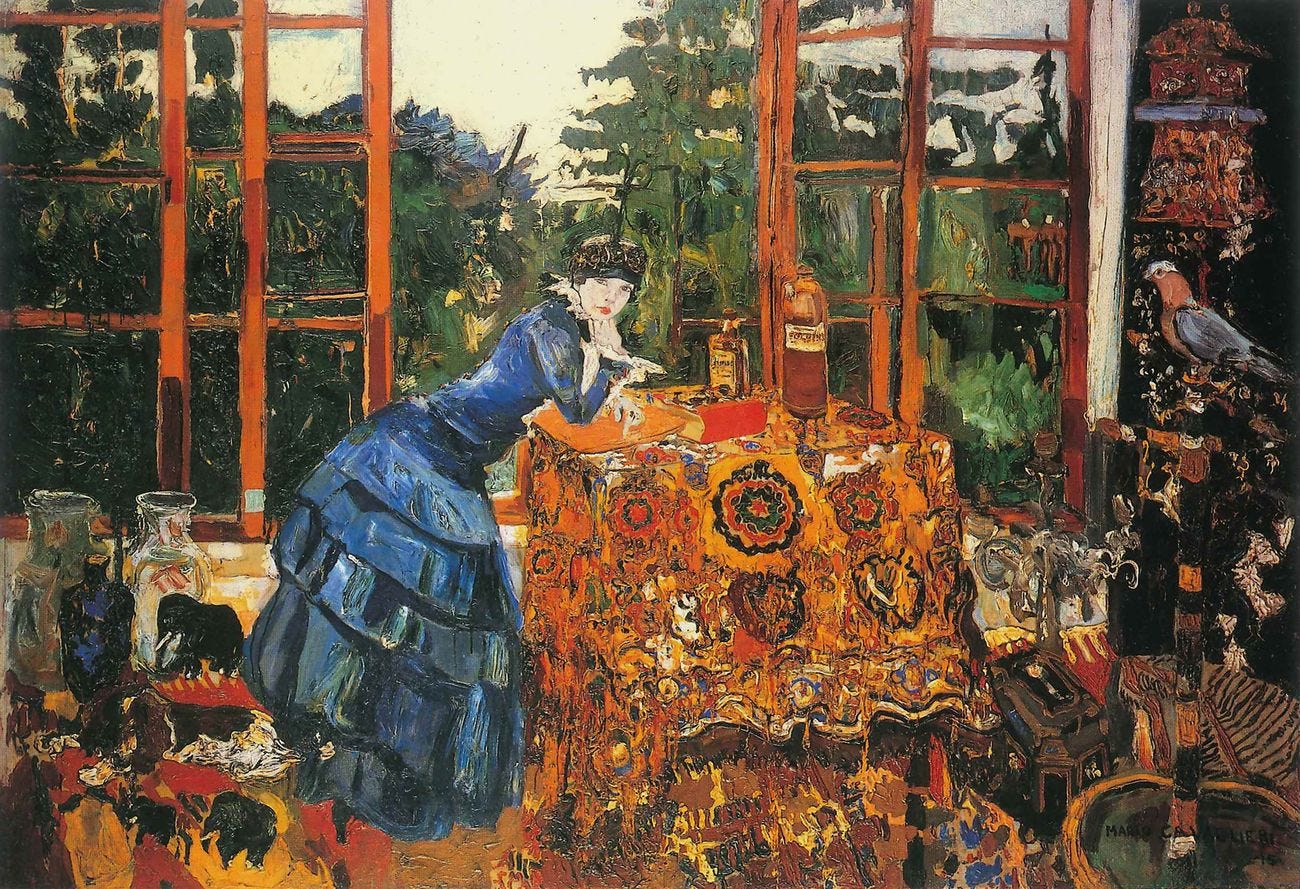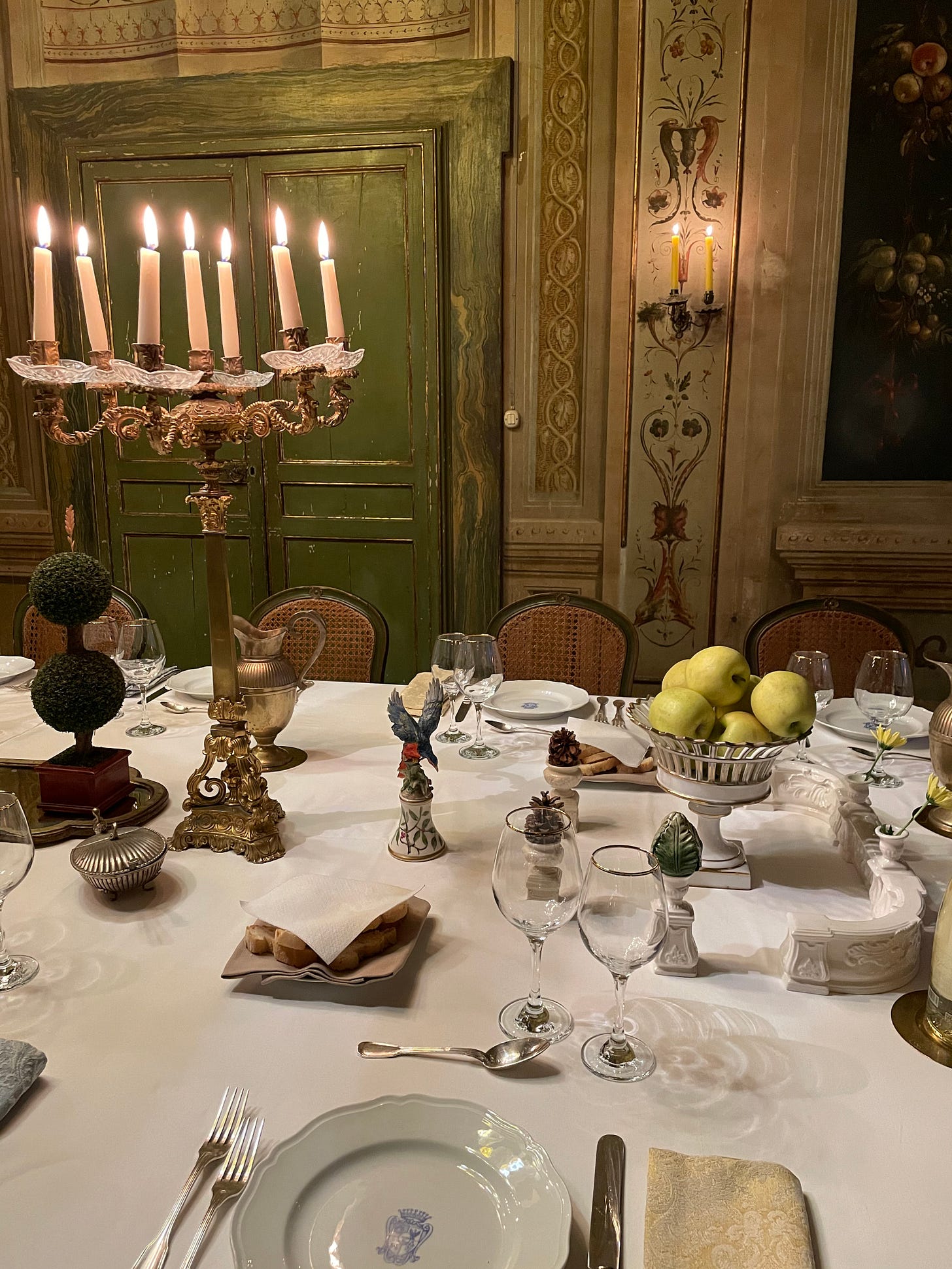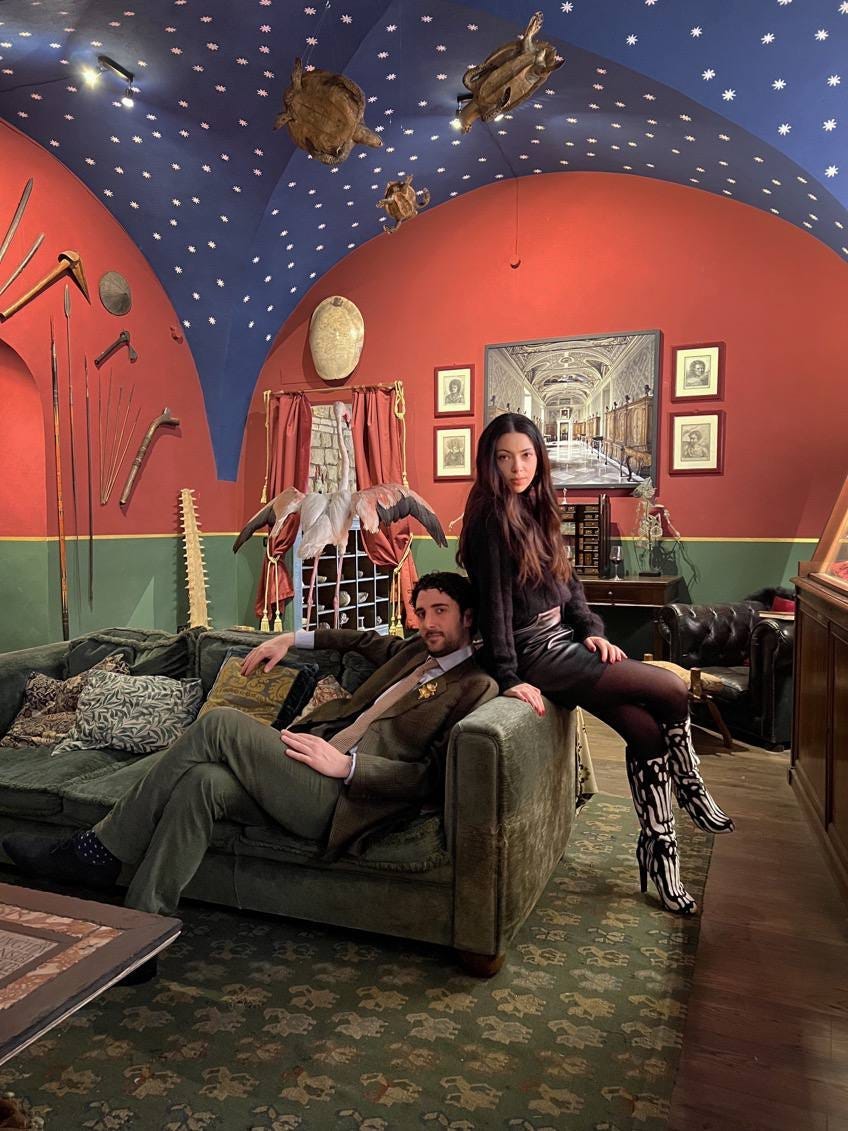#18 Rocaille newsletter - March 2023
Abitare come espressione dell'esistenza. Dalla villa siciliana di The White Lotus alla dimora aristocratica del fotografo d'interni Massimo Listri: la casa è il regno dell'io.
Questa è la newsletter gratuita di rocaille.it. La invio ogni mese, se non volete più riceverla potete cancellarvi dal link in fondo, se invece volete passare alla versione esclusiva a pagamento potete farlo cliccando qui.
This is rocaille.it's free newsletter, I send it every month, if you no longer want to receive it you can unsubscribe from the link at the bottom. If you would like to upgrade to the exclusive paid version, you can do so by clicking here.
C’è un che di malinconico nel crogiolarsi negli interni della propria casa, come questa donna circondata dagli oggetti, che si fa cosa tra le cose, decorazione tra i decori. Alle sue spalle una grande finestra la divide dal parco, un limine, il vetro, che separa la vita interiore dall’esterno, il mondo umano dalla natura.
Il tema di questa newsletter è l’abitare come espressione dell’io. Ogni mese tratterò un argomento diverso, ci sarà un dipinto e una citazione; a seguire una selezione di notizie tra mostre, articoli, novità e altre cose che succedono in questo mondo. Infine i miei eventi, viaggi e ebook.
Per tutti i nuovi iscritti o per chi mi ha chiesto di leggere le precedenti newsletter qui c’è l’archivio (può essere consultato liberamente).
Sono appena tornata da Napoli, città che insieme a Roma e Palermo considero tra le più grandiose d’Italia. È piena di bellezza, di storia, la natura ti schiaccia. Pensare che ogni giorno si possa assistere ad una visione così bella, il golfo con il Vesuvio sullo sfondo, toglie il fiato. Eppure è anche piena di inciviltà, sporcizia, disorganizzazione. Contrasti assoluti, forse insanabili.
Tornerò sicuramente entro l’anno, perché voglio conoscerla meglio. Nella newsletter a pagamento, che uscirà tra 2 settimane, vi dirò dove sono stata e le cose che ho visitato (in basso trovate l’anteprima). In questa versione ci sono le ricerche sui miei viaggi, con tutte le indicazioni dei luoghi, foto e informazioni più esclusive che non pubblico né sul blog né sui social. Potete abbonarvi facendo una donazione minima di 30€ qui.
A fine aprile invece mi aspetta un viaggio importante: per la prima volta andrò negli Stati Uniti d’America e starò 10 giorni a New York. Non so davvero cosa aspettarmi, non è un viaggio in linea con quelli che farei di solito e altri luoghi mi attraggono di più, ma sono curiosa. Visiterò sicuramente i musei più importanti e ho alcuni amici lì che mi stanno consigliando, ma se avete qualche cosa da suggerirmi scrivetemi pure!
Dwelling as an expression of existence. From the Sicilian villa of The White Lotus to the aristocratic home of interior photographer Massimo Listri: home is the realm of the self.
There is something melancholy about basking in the interiors of one's home, like this woman surrounded by objects, making herself a thing among things, decoration among decorations. Behind her, a large window divides her from the park, a limine, glass, separating inner life from the outside, the human world from nature.
The theme of this newsletter is dwelling as an expression of the self. Each month I will talk about a different topic, there will be a painting and a quote; followed by a selection of news from exhibitions, articles, news and other things happening in this world. Finally my events, travels and ebooks. For all new subscribers or those who have asked me to read previous newsletters here is the archive (free access).
I have just returned from Naples, a city that along with Rome and Palermo I consider among the greatest in Italy. It is full of beauty, history, nature overwhelms you. To think that every day you can witness such a beautiful sight, the gulf with Vesuvius in the background, takes your breath away. Yet it is also full of incivility, filth, disorganization. Absolute contrasts, perhaps irremediable. I will definitely return within the year, because I want to get to know it better. In the paid newsletter, which will come out in 2 weeks, I will tell you where I have been and the things I have visited. Here you will always find my travels, with all the directions to places, photos and more exclusive information that I don't publish either on the blog or on social media. You can subscribe by making a minimum donation of 30€ here. At the end of April, on the other hand, I have a big trip coming up: for the first time I am going to the United States of America and I will stay 10 days in New York. I really don't know what to expect, it's not a trip in line with the ones I would usually take and other places attract me more, but at least once NY must be seen. I am curious. I will definitely visit the major museums and I have some friends there who are recommending me, but if you have any suggestions please write to me!
La casa è il regno dell’io
Mi sono sempre chiesta da cosa derivi il mio amore smodato per gli interni, dalle case museo alle dimore storiche. Abitare, secondo alcuni filosofi, coincide con il concetto di esistere. Mario Praz1 (1896 – 1982) diceva: dimmi come abiti e ti dirò chi sei.
Ci sono due tipi di persone: quelli che non tengono affatto alla casa e quelli che ne fanno il proprio regno personalissimo e segreto. Questi ultimi godono nell’arredarla, nel cercare oggetti per abbellirla, nel creare ambienti piacevoli in cui trascorrere del tempo, da soli o con amici. Queste persone mi hanno sempre attratto, la loro capacità di trasformare un ambiente seguendo una propria visione, come se fosse lo specchio della loro anima, mi sembra un potere magico, fondamentale per evadere dal reale.
A proposito, il Museo Mario Praz a Roma ha chiuso nel 2019 a causa della pandemia e non ha più riaperto. Sono passati 4 anni, ma cosa aspettano?
Chi non è mai stato al museo può vedere il mio reportage sul blog qui e qui. Se non lo avete già fatto vi consiglio di leggere il suo libro “La casa della vita”.
Das an expression of the self
I have always wondered where my inordinate love for interiors, from house museums to historic mansions, comes from. Dwelling, according to some philosophers, coincides with the concept of existing. Mario Praz (1) (1896 - 1982) said: tell me how you live and I will tell you who you are. There are two kinds of people: those who do not care about the house at all and those who make it their very personal and secret realm. The latter enjoy decorating it, looking for objects to beautify it, creating pleasant environments in which to spend time, alone or with friends. These people have always attracted me, their ability to transform an environment following their own vision, as if it were the mirror of their soul, seems to me a magical power, essential to escape from reality.
- By the way, the Mario Praz Museum in Rome closed in 2019 because of the pandemic and has not reopened. It's been four years, but what are they waiting for?
- Those who have never been to the museum can see my blog report here and here. If you haven't already, I recommend reading his book "The House of Life."
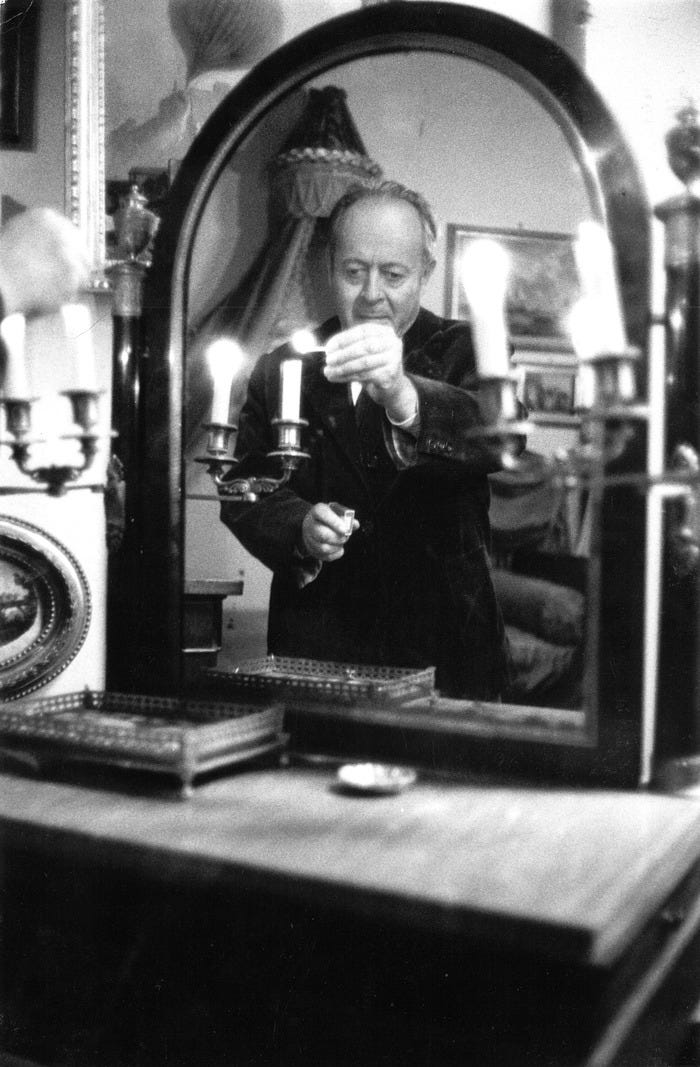
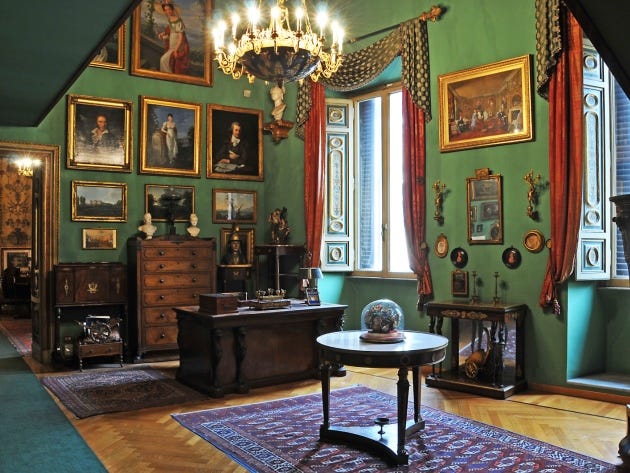
Non è questione di lusso: anche le celle dei monaci sono scrigni di pura bellezza, dove l’arredamento è ridotto ad un letto, una sedia e una croce e gli oggetti sono il simbolo di un’esistenza essenziale e adamantina. Né è questione di possesso, benché per molti uomini oggetti e arredamenti sono solo un modo per mostrare il proprio potere di acquisto, tipico atteggiamento dei parvenu.
Gli amanti della casa di cui sto parlando non sono questi, ma non sono nemmeno gli arredatori che lo fanno per lavoro, persone cioè che hanno padronanza di tutte le epoche e i relativi stili, tecnici della decorazione che riescono a costruire ambienti di grande impatto in base a richieste specifiche. E’ il caso del bravissimo Jacques Garcia (1947), che in Sicilia ha restaurato e arredato Palazzo Castelluccio a Noto, oggi aperto al pubblico, e la sua casa privata, Villa Elena, è diventata location della serie “The White Lotus”.
Garcia ha arredato molti ristoranti e hotel, soprattutto a Parigi e in Francia, oltre al suo castello Champ de Bataille, aperto alle visite. Qui invece alcune foto di Villa Elena a Noto.
It’s not a matter of luxury: even the monks' cells are treasure chests of pure beauty, where the furnishings are reduced to a bed, a chair and a cross and the objects are the symbol of an essential and adamantine existence. Nor is it a matter of possession, although for many men objects and furnishings are just a way to show off their purchasing power, a typical attitude of parvenus. The home-lovers I am talking about are not these, but neither are the interior decorators who do it for a living, that is, people who have mastered all eras and related styles, decorating technicians who are able to build striking environments according to specific requests. Such is the case with the very talented Jacques Garcia (1947), who in Sicily restored and furnished Palazzo Castelluccio in Noto, now open to the public, and his private home, Villa Elena, became the location for the series "The White Lotus."
- Garcia has furnished many restaurants and hotels, especially in Paris and France, as well as his castle Champ de Bataille, which is open for tours. Here instead are some photos of Villa Elena in Noto.


Colui che tiene alla propria casa molto più facilmente diventa collezionista, una persona cioè che trasfigura il valore delle cose, che ne intravede la bellezza quando nessun’altro lo fa. Arredare corrisponde ad un atto di amore: scegliere un oggetto invece di un altro significa preferire, quindi amare di più. Quella di queste persone è una ricerca continua e costante, che non finisce mai, le riconosci perché dell’oggetto amano ogni cosa e sono a contatto con la sua materialità, si sporcano le mani ad aggiustarle, ne conoscono ogni difetto.
Mi viene in mente Raniero Gnoli (1930), che da giovane era vicino di casa di Mario Praz nel palazzo di Via Giulia a Roma. Il Prof. Gnoli oggi abita una parte di un castello seicentesco vicino al lago di Bracciano. Quando vi si trasferì, nel 1964, era un pollaio. Oggi è così, luminoso, aristocratico e rustico, arredato con mobili antichi e centinaia di libri. Ho avuto la fortuna di incontrarlo a casa sua, che rispecchia perfettamente il suo mondo. Il professore, che è stato titolare della cattedra di Indologia a La Sapienza di Roma fino al 2000, autore di saggi di filosofia ed estetica indiana, grande conoscitore dell’archeologia romana, ha la passione della passamaneria. Colleziona nappe, cordoni, applicazioni di stoffe, ricami, pizzi e ne confeziona lui stesso per tendaggi o divani. Si diletta anche in piccole composizioni di marmi e dipinge nature morte in stile seicentesco, a mo’ di Giovanna Garzoni. Un uomo, oggi 93enne, pieno di delicatezza e di stupore.
Se volete sapere qualcosa in più su Raniero Gnoli potete leggere questa intervista.
He who cares for his home much more easily becomes a collector, that is, a person who transfigures the value of things, who glimpses their beauty when no one else does. Furnishing corresponds to an act of love: choosing one object over another means preferring, then loving more. That of these people is a continuous and constant search that never ends, you recognize them because of the object they love everything and are in contact with its materiality, they get their hands dirty fixing it, they know every flaw of it.
I am thinking about Raniero Gnoli (1930), who as a young man was Mario Praz's neighbor in the Via Giulia building in Rome. Prof. Gnoli today lives in part of a 17th-century castle near Lake Bracciano. When he moved there in 1964, it was a chicken coop. Today it is like that, bright, aristocratic and rustic, furnished with antique furniture and hundreds of books. I was lucky enough to meet him in his home, which perfectly reflects his world. The professor, who held the chair of Indology at La Sapienza in Rome until 2000, author of essays on Indian philosophy and aesthetics, a great connoisseur of Roman archaeology, has a passion for trimmings. He collects tassels, cords, fabric appliqués, embroidery, lace and makes some himself for curtains or sofas. He also dabbles in small marble compositions and paints still lifes in the seventeenth-century style, in the manner of Giovanna Garzoni. A man, now 93 years old, full of delicacy and wonder.
- If you want to know more about Raniero Gnoli you can read this interview.
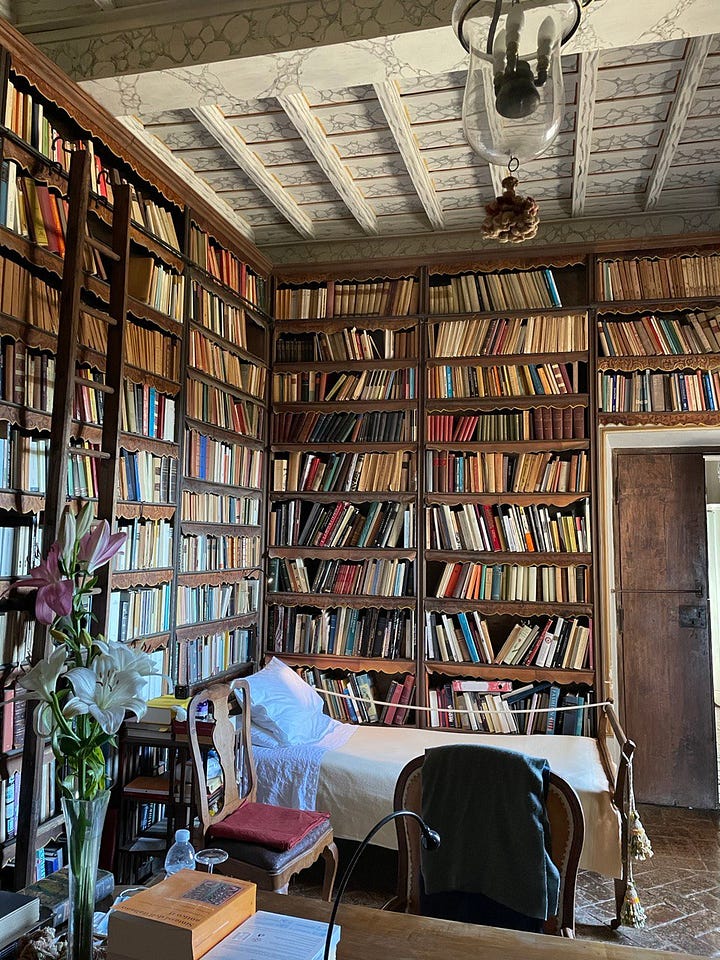

Dare attenzione ad una cosa che nessuno aveva considerato prima significa salvarla dall’oblio e destinarla ad un uso diverso da quello per cui era stata creata. Significa elevarla da un uso comune e utilitaristico ad uno sentimentale ed estetico. Ecco perché Robert de Montesquiou diceva che “un appartamento è uno stato d’animo”.
Questo tipo di arredatore, a differenza del collezionista, ama soprattutto la memoria degli oggetti, a prescindere dal loro valore. E’ un malinconico, che sente la vanità delle cose, vede che il loro morire è già in atto e il suo è un tentativo disperato di salvarle dalla fine.
Giving attention to something that no one had considered before means saving it from oblivion and putting it to a use other than the one for which it was created. It means elevating it from a common and utilitarian use to a sentimental and aesthetic one. That is why Robert de Montesquiou said that "an apartment is a state of mind." This type of decorator, unlike the collector, loves above all the memory of objects, regardless of their value. He is a melancholic, who feels the vanity of things, sees that their dying is already taking place, and his is a desperate attempt to save them from the end.
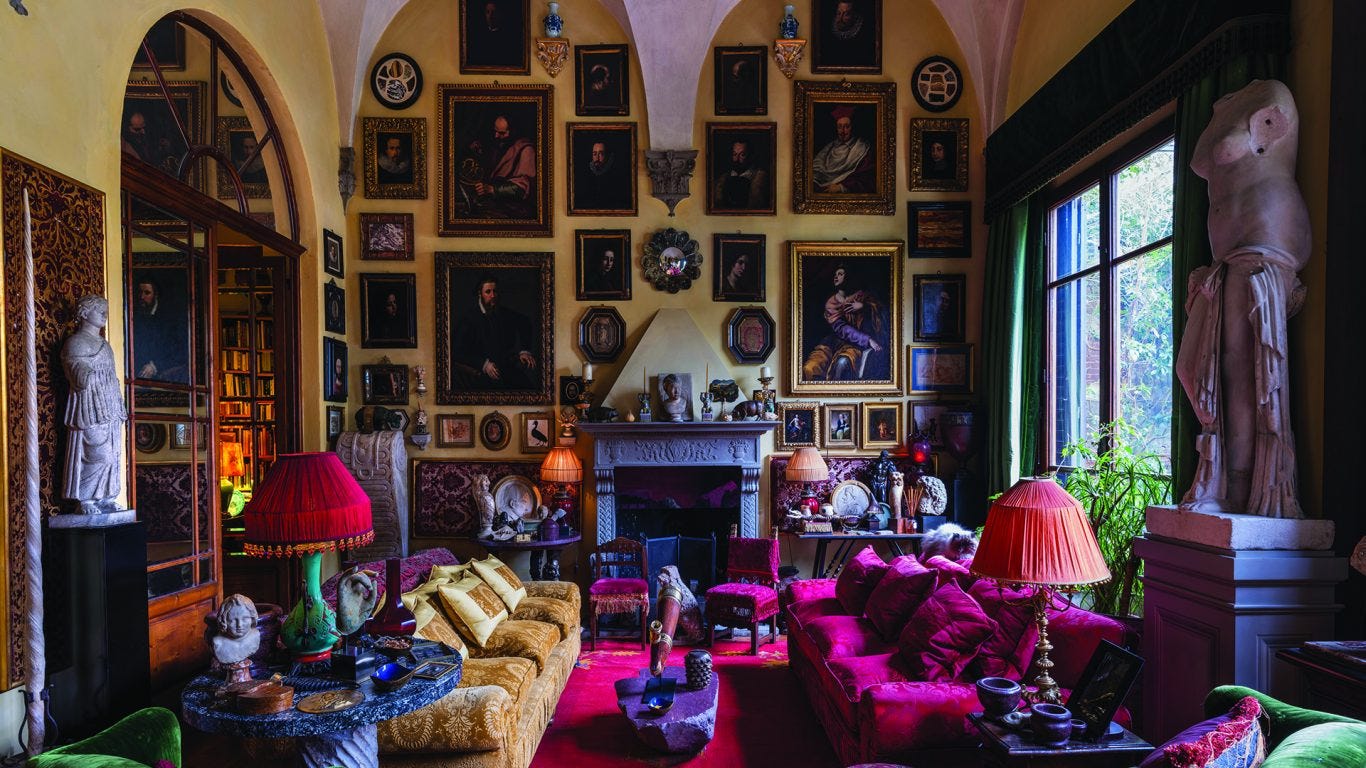
E’ facile sapere quando questa tendenza ha avuto inizio, tutto deriva dalle wunderkammer rinascimentali, poi evolute nelle collezioni personali del signore, dell’appassionato d’arte, fino alla casa museo ottocentesca. La storia è lunga, ma è chiaro che il senso per l’arredamento nacque nelle case dei ricchi e raffinati borghesi del nord Europa del Rinascimento e quindi nelle dimore toscane, prima ancora che italiane.
Toscano è Massimo Listri (1953), grandioso fotografo d’interni, che vive a Firenze: «abito nella stessa casa da quando avevo ventidue anni, e pian piano mi allargo da allora. Mi sono indebitato più volte, qualche volta ho comprato anche solo uno sgabuzzino dal marchese padrone di casa». In questa casa, oltre alle antichità, dalle sculture romane fino all’Ottocento, c’è anche un Léger del 1924 sul camino.
It is easy to know when this trend began; it all stems from the Renaissance wunderkammer, then evolved into the personal collections of the gentleman, the art enthusiast, to the nineteenth-century house museum. The history is long, but it is clear that the sense for furnishings was born in the homes of the rich and refined bourgeoisie of Renaissance northern Europe, and then in Tuscan, even before Italian, residences.
Tuscan is Massimo Listri (1953), a grand interior photographer who lives in Florence: "I have lived in the same house since I was twenty-two years old, and I have been slowly expanding ever since. I've gone into debt several times, sometimes I even bought just a closet from the marquis who owns the house." In this house, in addition to antiquities from Roman sculptures to the 19th century, there is also a 1924 Léger on the mantelpiece.
A leggere queste storie si può pensare che per creare un ambiente bello bisogna essere per forza ricchi. Avere soldi certamente facilita, ma il gusto non si può comprare. Avere un mondo interiore è l’unica prerogativa necessaria per decorare la propria casa. E’ sufficiente, a volte, anche solo una camera. Xavier de Meistre (1763 – 1852), che nel suo romanzo Voyage autour de ma chambre immagina un viaggio avventuroso tra oggetti della sua stanza rimanendo seduto sulla poltrona, scrive:
“Il diletto di viaggiare nella propria camera è immune dall'inquieta gelosia degli uomini e indipendente dalla fortuna”
Reading these stories, one might think that to create a beautiful environment one has to be rich. Having money certainly makes it easier, but taste cannot be bought. Having an inner world is the only prerequisite needed to decorate one's home. It is enough, sometimes, even just one room. Xavier de Meistre (1763 - 1852), who in his novel Voyage autour de ma chambre imagines an adventurous journey among objects in his room while remaining seated in his armchair, writes: "The delight of traveling in one's room is immune from the restless jealousy of men and independent of fortune."
News, events, exhibitions, articles

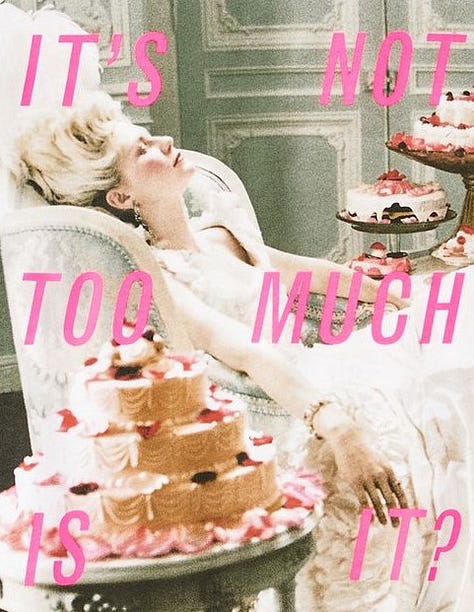
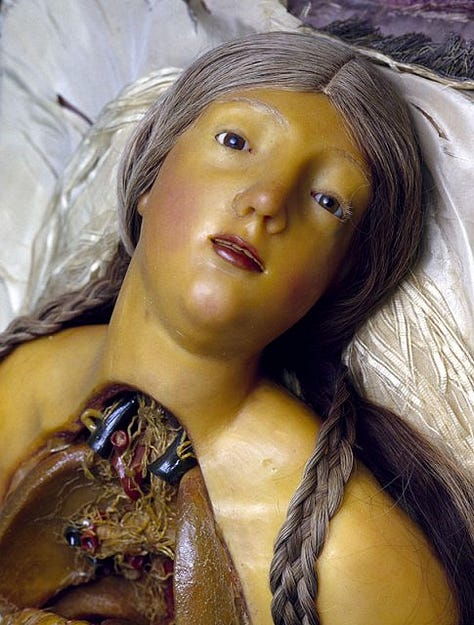
Al Museé Marmottan di Parigi ha aperto da poco una mostra che vorrei tanto vedere sui pittori Neoromantici. Non fatevi ingannare dal nome, il romanticismo ottocentesco non c’entra nulla, si tratta di un gruppo di pittori attivi tra gli anni ‘40-’60 che proposero, dopo la guerra, una nuova formula di pittura figurativa. Fino al 18 giugno.
Apre tra pochissimi giorni una mostra importantissima su Vittore Carpaccio al Palazzo Ducale di Venezia. Fino al 18 giugno.
Un bel motivo per andare a Ferrara è la mostra inaugurata a Palazzo dei Diamanti su Ercole de’ Roberti e Lorenzo Costa, grandi artisti del rinascimento ferrarese e caposaldi della scuola pittorica locale. Curata da Sgarbi, fino al 19 giugno.
Sempre Sgarbi è curatore di un’altra bella mostra, a Sutri, in provincia di Viterbo, il paese di cui è sindaco da ormai 5 anni e che probabilmente sta per lasciare. Si intitola infatti “Triste, solitario y final” ed espone 17 pittori e scultori che spaziano in generi ed epoche diverse, da metà '900 ai giorni nostri. Fino al 1 ottobre.
Sembra imperdibile la grande rassegna su Perugino, in occasione del V centenario della sua morte, esposta alla Galleria Nazionale dell’Umbria di Perugia. Fino all’11 giugno.
E’ sempre un anniversario a dar avvio a due grandi mostre al Vittoriale degli Italiani: in occasione del 160esimo anniversario della nascita di D’Annunzio, inaugureranno due mostre. La prima, Viani al Vittoriale, è dedicata al pittore viareggino Lorenzo Viani, fino a settembre negli spazi di Villa Mirabella. La seconda esposizione sarà, invece, incentrata sulla figura del grande imprenditore e mecenate del ‘900 Vittorio Cini, allestita presso il Ricovero del MAS e all’interno del D’Annunzio Segreto.
Una grande retrospettiva su Felice Casorati sarà inaugurata tra poco alla Fondazione Magnani Rocca a Traversetolo, vicino Parma. Fino al 2 luglio.
Se siete vicino Parma non perdetevi gli incontri organizzati dal Labirinto della Masone: 7 appuntamenti dal 14 aprile al 9 giugno, dal titolo “Il filo di Arianna”, dedicati a personaggi errabondi, complessi, inclassificabili. Qui il calendario.
Una notizia pop: gli amanti della regista Sofia Coppola ameranno sapere che Uniqlo ha creato una serie di t-shirt con alcune scene dei suoi film.
A Milano, interessante mostra sul fotografo Guy Bourdin all’Armani Silos.
Da Fondazione Prada invece, sta per aprire una mostra sulle cere anatomiche! Da vedere quanto l’intervento del regista Cronenberg, che cura la mostra, risulti integrato con le opere.
Lo studio sui mostri di Ulisse Aldrovandi è stato pubblicato per la prima volta in italiano, dopo 400 anni, da Moscabianca Edizioni.
- At the Museé Marmottan in Paris an exhibition recently opened that I would love to see on the Neo-Romantic painters. Don't be fooled by the name, nineteenth-century Romanticism has nothing to do with it; this is a group of painters active between the 1940s and 1960s who proposed a new formula of figurative painting after the war. Through June 18.
- A very important exhibition on Vittore Carpaccio opens in a few days at the Doge's Palace in Venice. Through June 18.
- A good reason to go to Ferrara is the exhibition opening at the Palazzo dei Diamanti on Ercole de' Roberti and Lorenzo Costa, great artists of the Ferrara Renaissance and cornerstones of the local school of painting. Curated by Sgarbi, through June 19.
- Sgarbi is also curator of another fine exhibition, in Sutri, in the province of Viterbo, the town of which he has been mayor for five years now and is probably about to leave. It is in fact titled "Triste, solitario y final" and exhibits 17 painters and sculptors spanning different genres and eras, from the mid-20th century to the present day. Through Oct. 1.
- The major exhibition on Perugino, on the occasion of the fifth centenary of his death, on display at the National Gallery of Umbria in Perugia seems not to be missed. Through June 11.
- It is always an anniversary that kicks off two major exhibitions at the Vittoriale degli Italiani: on the occasion of the 160th anniversary of D'Annunzio's birth, two exhibitions will open. The first, Viani al Vittoriale, is dedicated to the Viareggio painter Lorenzo Viani, until September in the spaces of Villa Mirabella. The second exhibition, on the other hand, will focus on the figure of the great 20th-century entrepreneur and patron Vittorio Cini, set up at the MAS shelter and inside the D'Annunzio Segreto.
- A major retrospective on Felice Casorati will open soon at the Magnani Rocca Foundation in Traversetolo, near Parma. Through July 2.
- If you are near Parma, don't miss the meetings organized by the Labyrinth of the Masone: 7 appointments from April 14 to June 9, entitled "Ariadne's Thread," dedicated to wandering, complex, unclassifiable characters. Calendar here.
- Pop news: lovers of director Sofia Coppola will love to know that Uniqlo has created a series of t-shirts featuring scenes from her films.
- In Milan, interesting exhibition on photographer Guy Bourdin at Armani Silos.
- At Fondazione Prada, on the other hand, an exhibition on anatomical waxes is about to open! To be seen how well the intervention of director Cronenberg, who curates the exhibition, turns out to be integrated with the works.
Rocaille Experience “The secrets of Tuscia”
19-20-21 May 2023
Castelli rinascimentali e ville degli anni ‘30, boschi e giardini simbolici, cena al lume di candela circondati da affreschi del ‘600. A primavera ripeterò la Rocaille Experience in Tuscia, la zona senza confini precisi tra il nord del Lazio, il sud della Toscana e l'Umbria occidentale.
Dettagli:
Dalla sera di venerdì 19 Maggio alla domenica del 21 maggio.
La quota singola è di 490€ (cambia, in proporzione, per una coppia). NON comprende trasporti o altro non specificato.
Per conoscere il programma completo potete leggere la brochure qui.
Per prenotare invece dovete compilare il modulo qui.
Se avete domande o semplici curiosità scrivetemi a info@rocaille.it con oggetto "Tuscia Experience".
NB Le camere del palazzo sono limitate, per cui un volta raggiunto il limite non sarà più possibile partecipare.
NE RIMANGONO SOLO 5 !
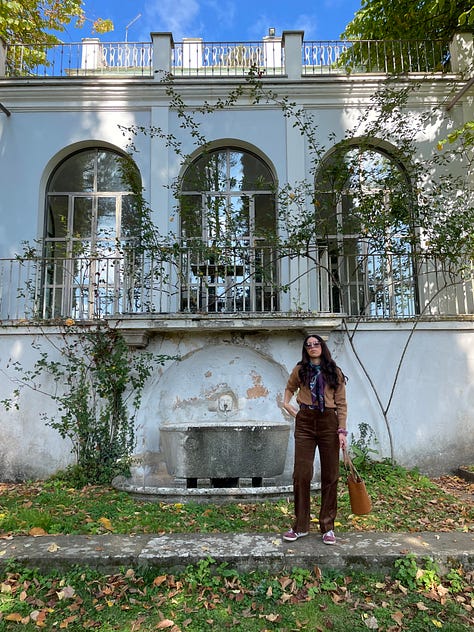

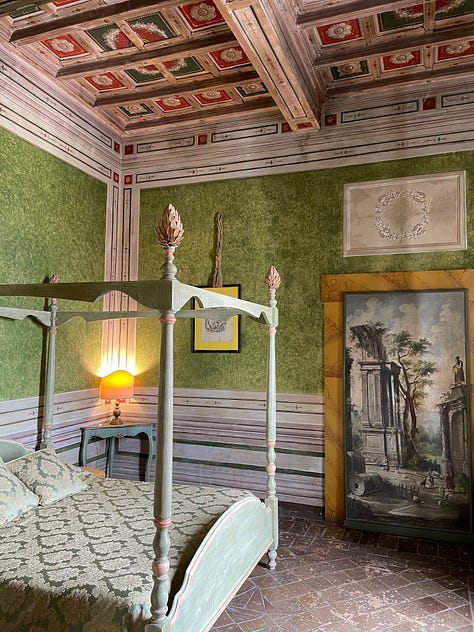
Renaissance castles and 1930s villas, symbolic forests and gardens, candlelight dinner surrounded by 17th-century frescoes. In the spring I will repeat the Rocaille Experience in Tuscia, the area without precise boundaries between northern Lazio, southern Tuscany and western Umbria.
Details:
- From the evening of Friday, May 19 to Sunday, May 21.
- Single fee is 490€ (changes proportionately for a couple). It does NOT include transportation or anything else not specified.
- To know the full program you can read the brochure here.
- To book instead you need to fill out the form here.
- If you have other questions or simple curiosities write to me at info@rocaille.it with the subject line "Tuscia Experience."
NB Rooms in the palace are limited, so once the limit is reached you will no longer be able to participate.
THERE ARE ONLY 5 LEFT !
ALTRI EVENTI
Corso sulle case museo a Diorama Gallery
Sono rimasti due incontri del corso sulle case museo in collaborazione con Niccolò Mottinelli di Diorama Gallery.
PREVIEW
Exclusive newsletter - March 2023
Little guide to Naples: all the places, restaurants and secret spots that I discovered.
Out on March 30!

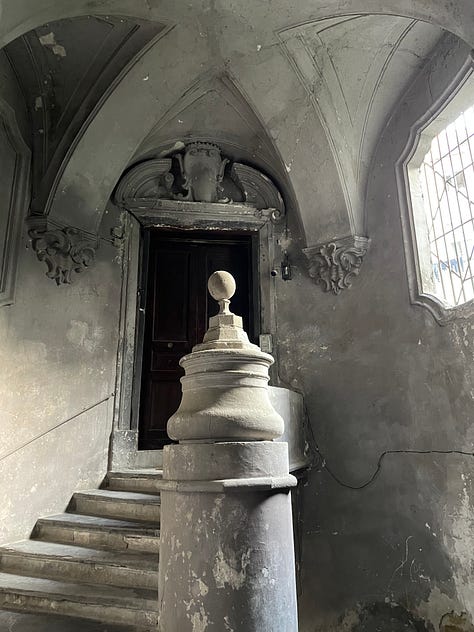
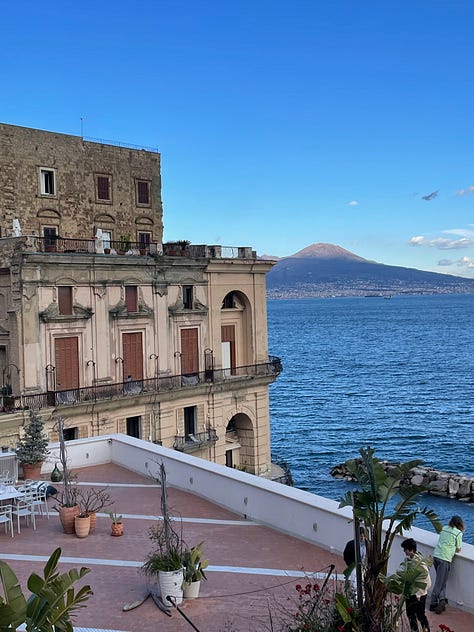






BUY MY EBOOKS
italian & english
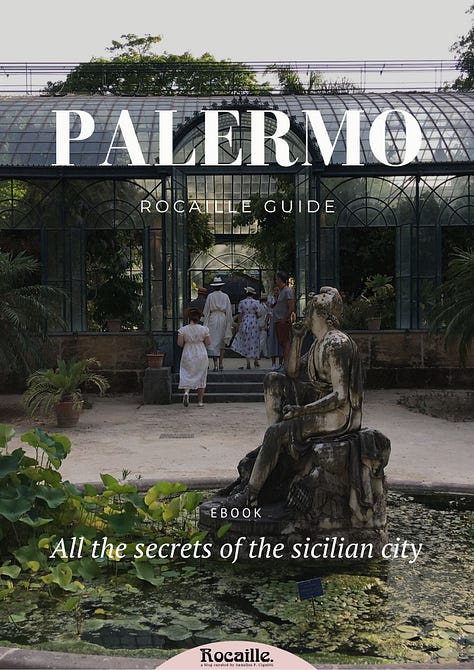


Il tema di questa newsletter non è altro che una piccola riflessione sul primo capitolo di Mario Praz, La filosofia dell’arredamento, saggio insuperato per quanto riguarda la decorazione d’interni.



